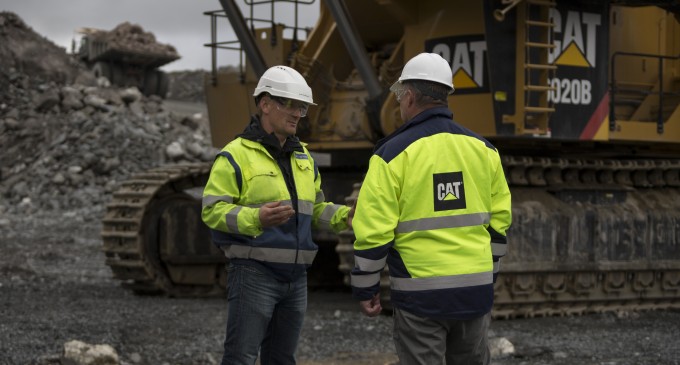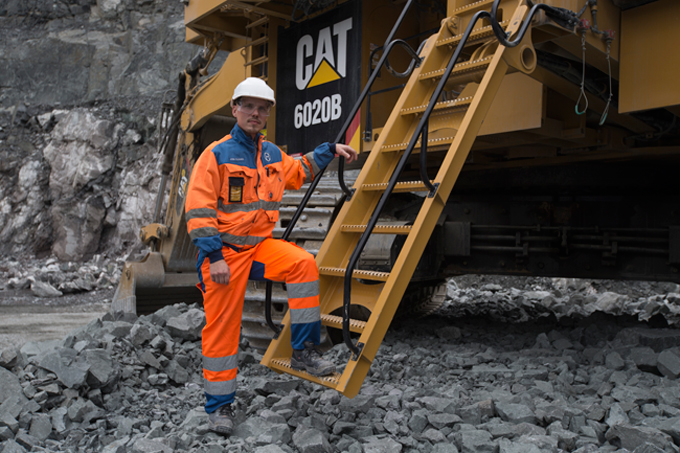“Mining companies are looking at ways to reduce their operating expenses in light of the downturn in the industry,” says Rick Rathe, Managing Director at Caterpillar, Inc. Given that 20-30 percent of operational expenses at most mines are related to energy costs, finding innovative energy solutions is appealing, he contends. “In this environment of cost-cutting and trying to reduce expenses, lowering costs is a key element of many mining strategies to try and improve profitability and remain open for business.”
From a levelized cost of energy perspective, it’s clear that both solar and wind energy mean a lower cost of energy over the long haul, says Rathe. However, upfront capital costs for renewables are much higher—and that poses a challenge in today’s environment. Another stumbling block is that mines often pay consultants to design a custom solution for each site and purchase products from component providers in a piecemeal fashion—and so they lack an integrated and proven renewable solution.
For Rathe, the answer is providing a complete Cat®-branded microgrid solution that works along with Caterpillar’s existing generation equipment and lowers both the overall cost of energy while reducing carbon and gaseous emissions. When mines can purchase a factory-proven, renewable package that’s been replicated many times in the past, some of the headaches will disappear.
An Integrated Solution
In the current environment, mines are working with “a hodgepodge of different component suppliers and inverter or solar manufacturers, none of which really has the footprint to support those products like Caterpillar, due to our longstanding network of dealers in every part of the world,” says Rathe. The problem with cobbling together a PV [photovoltaic] solution? This enterprise quickly devolves into “an engineering project,” with consultants choosing the lowest bids in a variety of categories and then trying to make it all work, he contends.
When the solution is piecemeal, says Rathe, the customer is stuck with a shaky solution and integration may be far more challenging than expected. In addition, if the mining customer has a problem with one of the components, the manager has to deal with many different individuals, all of whom engage in finger pointing and none of whom are accountable.
Rathe states: “That’s why we want an integrated solution. We think there’s value from having quality control in the design and optimizing the efficiency of all the different components.”
In order to provide an integrated solution, Rathe began looking for companies with proven track records and solutions that could be replicated anywhere in the world. “We want something our customers have confidence will work for the next 20 years and something that our Cat dealer network will support globally,” he says. “Caterpillar’s ability to integrate solar solutions is only one aspect of its offerings; the true beauty resides in its ability to service its solutions and keep them running for the life of a particular microgrid, which might easily extend for 25-to-30 years.”
To this end, Caterpillar has been seeking the best technology in solar, inverters, energy storage and micro-grid controllers. And after an exhaustive search, Caterpillar forged a strategic partnership with First Solar for its micro-grid customers. Rathe explains that Caterpillar selected First Solar because it is a leader in terms of utility-scale solar, with over 10 gigawatts of PV on the ground today. That said, First Solar sees the benefits of having a global distribution and support network for microgrid projects, which tend to be more dispersed in terms of location.
In addition, Rathe prefers First Solar’s thin-film technology to multi-crystalline technologies. He believes that the energy capture in high ambient temperature and humid areas can be as much as 10-15 percent greater with thin-film technology than multi-crystalline. He also believes that First Solar has solid plans to improve its efficiency in the next few years, while the efficiency gains from the multi-crystallines have been relatively flat in recent years. Efficiency wins business.
Next, Caterpillar selected SMA Solar Technology as its supplier of solar inverters. SMA is the industry leader in solar inverters and has worked extensively with First Solar to match their inverters to the thin film solar panel technology. Caterpillar is bundling the solar panels, inverters and ground mount racking system together into a 25 kilowatt building block that can easily be expanded and replicated anywhere in the world. For large systems, above 5 megawatts, Caterpillar will leverage SMA’s line of central inverters.
For energy storage, Caterpillar has developed its own bi-directional inverters, based off of work done at Caterpillar in hybrid mining and construction equipment. These inverters allow Caterpillar to provide a full range of energy storage products, ranging from ultra-capacitors for short duration, lithium ion batteries for ride- through and metal air cells for long duration/time shift energy storage. “Our goal is to provide mining customers the best available energy storage technology for every application,” Rathe says.
Making It Work
For hybrid microgrids to flourish, financing is a necessary part of the equation. Rathe points out that mines are seeking creative financing or power purchase agreements to spread the costs over a longer period of time while keeping down initial capital costs.
Rathe points out that banks will have far more confidence in a proven, integrated solution if a track record exists. “We want standardization on a solution because it’s key to financing. Banks want to know this project has been done ten times,” he says. “Banks will then have confidence that this solution works and that any risks are minimized.”
Nowadays, banks and private equity firms are interested in backing large-scale, utility solar projects—and this willingness lowers the overall cost for such projects, says Rathe. “We want a standard design, standard maintenance and repair contract, and standard monitoring so we can bundle multiple projects at various sites and lower the cost of financing,” he says, explaining that financing accounts for roughly 35 percent of the overall cost of installing PV.
Caterpillar’s integrated solution removes some of the most pressing financial worries by offering financing for its PV products, whether it’s loans or leases. And through partners, the company can also offer PPAs with no capital outlay
A Look to the Future
The most cost effective way to reduce energy expenses is to reduce demand. Rathe points out that there are considerable opportunities, from installing LED light bulbs to examining how to avoid large energy spikes, to collecting data from Cat-powered mining trucks to reduce fuel consumption. “There’s a lot to be gained in figuring out how to further optimize mine site operations and energy usage,” he says.
In his scenario for the future, Rathe envisions tighter integration, which will include collecting data across “mine site operations, generation assets, distribution equipment and loads.”
“I think in the future we’ll be talking more about big data and how we better integrate the generation assets at a mine site with operational loads,” he says. By gaining these insights into both generation and demand, it’s possible to optimize the energy usage of the site.
As an example, Rathe notes that many miners run multiple units for spinning reserves in order to avoid a scenario in which a large spike of energy shuts down the powerhouse. In the future, however, he imagines predictive demand modeling with short duration energy storage, like ultra-capacitors, that allow mine operators to shut off more gensets. For Caterpillar, though, the true answer resides in creating the best integrated solution imaginable.
“We want our customers to have confidence installing our solution—we want them to know it’s going to work—and then to have confidence that in 20 years, it’s still going to work,” Rathe concludes. “I think we’re moving from science projects to commercialized solutions. And that’s truly our goal.”



